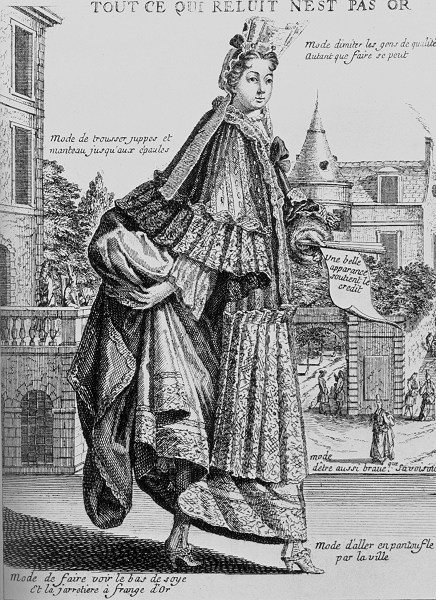"One of the earliest surviving French luxe mules, just the kind of slipper Cinderella wore to the ball"
Similarly, the mule was a shoe once only worn at home, like a house slipper. It was much easier to slip off (important for both the Cinderella tale and the perceived image of the mule)-plus its connotations as a shoe formerly worn in the bedroom gave it sexual overtones. Fashion engravings, the only form of fashion advertising, were getting more and more scandalous-hard as it is for us to imagine, at one time it really was shocking for a woman to reveal her ankles, and the mule allowed that.
THIS IMAGE MIGHT NOT BE SAFE FOR WORK...if you work in 1697
One thing I never realized is that Madame D'Aulnoy's tale "Finette Cindron" was essentially a competition, at the time, for Perrault's "Cendrillon." The two tales were published only months apart, and both were the author's versions of the oral Cinderella tales in circulation. Clearly Perrault's story has won out in popular imagination, but they're interesting to compare and contrast. Some people have already supposed that the Cinderella tale is really one about a foot fetish; Joan deJean makes the case that this is even more likely in "Finette Cindron."
 The story is sort of like a mashup of "Cinderella" and "Hansel and Gretel", complete with a mother attempting to abandon her children in the woods, and an ogre wanting to eat them and being outwitted and burned in his own oven. The story is longer and more complicated which is probably partly why it was never as popular. I noticed upon reading that shoes are prominently featured throughout the story: in poverty at the beginning, the soles of her shoes become worn through from walking to her godmother's; in servitude to her sisters, her job is to polish their shoes. Your relationship to shoes would have determined your status in France back them (as some people might say is also the case today, from the celebrities with closets full of designer heels, to those who can barely afford one pair, if that).
The story is sort of like a mashup of "Cinderella" and "Hansel and Gretel", complete with a mother attempting to abandon her children in the woods, and an ogre wanting to eat them and being outwitted and burned in his own oven. The story is longer and more complicated which is probably partly why it was never as popular. I noticed upon reading that shoes are prominently featured throughout the story: in poverty at the beginning, the soles of her shoes become worn through from walking to her godmother's; in servitude to her sisters, her job is to polish their shoes. Your relationship to shoes would have determined your status in France back them (as some people might say is also the case today, from the celebrities with closets full of designer heels, to those who can barely afford one pair, if that).Then enter the fairy shoes: "red velvet mules completely encrusted with pearls," and Finette is the talk of the town. DeJean points out one interesting difference between Perrault's and D'Aulnoy's tales: in Perrault, Cinderella lets her shoe drop, on purpose; in D'Aulnoy, Finette loses it accidentally (easily done with mules). She and the prince have never even met; the Prince becomes obsessed, but it's more clear that it's with the shoe itself. The Prince held it, "turned it this way and that, kissed it, caressed it, and took it home with him." He does agree to marry the woman who fits the shoe, but deJean suggests it's because then he would have access to a closet full of "tiny, lovely" shoes.
And, just as the stepsisters are willing in the Grimm story to mutilate their feet to fit into the coveted shoe, D'Aulnoy gives us another image to make us squirm: "every woman washed her feet with the sorts of waters, pastes, and pomades. Some ladies actually had them peeled, while others starved themselves in order to make their feet smaller and prettier." *Shudder*
(Although...wouldn't it be a lot easier to fit into a shoe a couple sizes smaller if they were mules?)
"D'Aulnoy's alternate version of the Cinderella story is the perfect icon for what can be seen as the first shoe-obsessed age. In a country ruled by a monarch who never tired of displaying his footwear, shoes became central to every outfit and to many psyches."
*Source: The Essence of Style: How the French Invented High Fashion, Fine Food, Chic Cafes, Style, Sophistication, and Glamour, by Joan deJean (chapter 3-"Cinderella's Slipper and the King's Boots", which also references "Puss in Boots")






Fascinating!!
ReplyDelete"THIS IMAGE MIGHT NOT BE SAFE FOR WORK...if you work in 1697" - LOL!!
ReplyDeleteGreat article K! This is exactly the sort of thing I'd love to have you guest post for OUABlog sometime. Fairy tales + fashion + you! :)
I've always wondered why everything disappeared at midnight except the shoes... :-) You do realise that big if the story probably goes back to the Herodotus story of Rhodopis and the Pharoah? An eagle snatches the fur slipper and the king wants to know whose it is...
ReplyDeleteYes, I've often wondered why Rhodopis often isn't credited as being the first Cinderella story, and I think it's because she doesn't suffer from persecution, like Yeh Shien and many of the other Cinderellas that came afterwards. I figured, for the purpose of this post, I would just focus on Perrault and his time period, but the whole concept of identification of a wife by a shoe is truly fasnicating
Delete"That bit of the story." Typo!
ReplyDelete